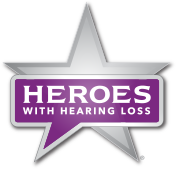Tips for Talking with Veterans (or anybody else) with Hearing Loss
Learning better ways to communicate with individuals who are deaf or hard of hearing can benefit everyone. However, when it comes to veterans with hearing loss, the standard operating procedures may have a slight twist. That’s because many veterans have multiple health issues that can impact their hearing loss and create situations that call for alternative solutions.
Here are our top tips for enhancing communication with a veteran near you.
Be patient, positive, and relaxed
It may take a little more time for some veterans to process what has been said. Veterans who have hearing loss may also have a traumatic brain injury (TBI) or other condition that is not immediately noticeable. That means they may receive incomplete auditory or neurological signals and it could take more time for them to make sense of the conversation. People with TBI or Post Traumatic Stress Disorder (PTSD) often have difficulty concentrating and may ask you to repeat what you’ve said.
Be respectful
This is just good advice for everyday living, but it’s especially important when talking with someone who has hearing loss. Most people will appreciate even the small things you do to enhance communication. However, it’s always best to get permission from a veteran before assuming your intentions are right. It’s also always best to avoid being too pushy. Veterans, especially those who have PTSD, often don’t talk much, and rarely about themselves – let them speak at their own pace or respect the fact that they may not want to speak at all. Resist the urge to ask a veteran to talk about subjects that he or she does not wish to share.
Get the person’s attention before you speak
It’s much easier to catch vocal and facial cues with a good view of a person’s face. Some people rely on reading the other person’s lips to better understand what’s being said…How you get someone’s attention is important, too. It’s always better to err on the side of subtlety. Shouting is never a good idea as veterans may be more sensitive to loud noises and sudden movements.
Use facial expressions and gestures
Visual cues add information that can help people with hearing loss understand the meaning of a conversation. Exactly how much of communication is “nonverbal” hasn’t been decided, but most experts agree it’s a lot. People who have trouble hearing rely heavily on emphasis and tone, as well as facial expressions, gestures, and posture to grasp the full meaning of a conversation.
Don’t cover your mouth or chew while speaking
This is just good manners like your parents taught you, but it’s especially important to remember around a person who has hearing loss. Having something in front of or inside of your mouth makes it difficult for people to understand what you’re saying. It’s also distracting, which may make conversation harder to follow for someone who also has TBI or PTSD.
Speak clearly and concisely and use a moderate pace & volume
Avoid rambling and mumbling. Speaking clearly will make it easier for people to understand what you’re saying. Keeping ideas short and to the point can make it easier for individuals who have TBI and PTSD to process, but don’t overdo it! Don’t assume you need to talk extra loudly or slowly to someone with hearing loss or other health issues as that can be insulting. However, do speak up or slow down when someone asks.
When you are not understood, try rephrasing what you said.
Simply repeating something when someone says “huh?” or “what?” might not always be the best way to get the message across. It may be a specific sound or frequency that the person has difficulty understanding. Saying things in different ways creates more opportunities for the brain to unlock the information.
Give cues or indicators when changing the subject
It’s especially difficult for individuals with hearing loss to completely follow every conversation. When you add in PTSD or a TBI, it can be particularly challenging, especially when the subject changes. If you take the time to pause or throw in a catchphrase like “…hey, switching gears…” it can be a subtle and helpful way to keep everyone tracking.
Choose places that are well lit and avoid excess noise
Where you have a conversation matters. Since people with hearing loss rely on visual clues to decode conversations, being able to see well is essential. Good lighting and minimal ambient noise are great ingredients for a smooth conversation. If you’re in a restaurant, don’t hesitate to ask your host or server for some help in finding a prime location. For many veterans choosing a spot that is secure (back to a wall or facing an exit) is always a good idea as well.
Encourage speaking one at a time
Listening is the shortest distance to understanding. Unfortunately, it’s easy for most of us to concentrate more on what we’re about to say rather than on what’s being said at the moment. Overlapping conversation isn’t a recipe for success under any circumstances, and when you add hearing loss to the mix, it’s especially tricky. Listen, process, and then respond – these are always good tips to remember.
Ask for suggestions!
The person you are talking to probably already knows what you can do to make communicating easier. Simply asking what you can do to help the conversation run smoothly is a good tip to try on everyone.
 Heroes With Hearing Loss
Heroes With Hearing Loss